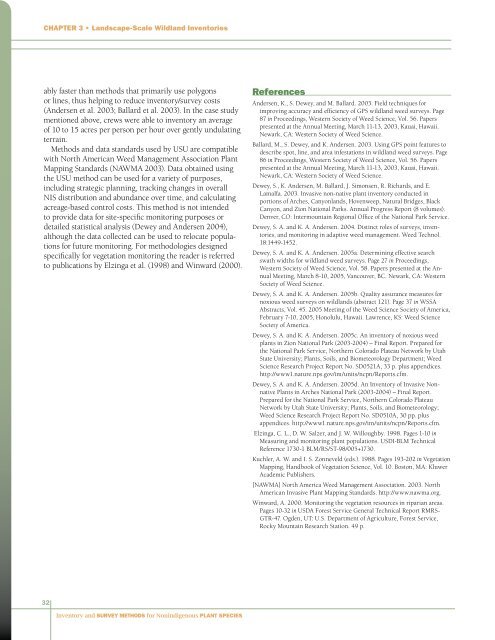Inventory and Survey Methods for Nonindigenous Plant Species (PDF)
Inventory and Survey Methods for Nonindigenous Plant Species (PDF)
Inventory and Survey Methods for Nonindigenous Plant Species (PDF)
- No tags were found...
Create successful ePaper yourself
Turn your PDF publications into a flip-book with our unique Google optimized e-Paper software.
Chapter 3 • L<strong>and</strong>scape-Scale Wildl<strong>and</strong> Inventoriesably faster than methods that primarily use polygonsor lines, thus helping to reduce inventory/survey costs(Andersen et al. 2003; Ballard et al. 2003). In the case studymentioned above, crews were able to inventory an averageof 10 to 15 acres per person per hour over gently undulatingterrain.<strong>Methods</strong> <strong>and</strong> data st<strong>and</strong>ards used by USU are compatiblewith North American Weed Management Association <strong>Plant</strong>Mapping St<strong>and</strong>ards (NAWMA 2003). Data obtained usingthe USU method can be used <strong>for</strong> a variety of purposes,including strategic planning, tracking changes in overallNIS distribution <strong>and</strong> abundance over time, <strong>and</strong> calculatingacreage-based control costs. This method is not intendedto provide data <strong>for</strong> site-specific monitoring purposes ordetailed statistical analysis (Dewey <strong>and</strong> Andersen 2004),although the data collected can be used to relocate populations<strong>for</strong> future monitoring. For methodologies designedspecifically <strong>for</strong> vegetation monitoring the reader is referredto publications by Elzinga et al. (1998) <strong>and</strong> Winward (2000).ReferencesAndersen, K., S. Dewey, <strong>and</strong> M. Ballard. 2003. Field techniques <strong>for</strong>improving accuracy <strong>and</strong> efficiency of GPS wildl<strong>and</strong> weed surveys. Page87 in Proceedings, Western Society of Weed Science, Vol. 56. Paperspresented at the Annual Meeting, March 11-13, 2003, Kauai, Hawaii.Newark, CA: Western Society of Weed Science.Ballard, M., S. Dewey, <strong>and</strong> K. Andersen. 2003. Using GPS point features todescribe spot, line, <strong>and</strong> area infestations in wildl<strong>and</strong> weed surveys. Page86 in Proceedings, Western Society of Weed Science, Vol. 56. Paperspresented at the Annual Meeting, March 11-13, 2003, Kauai, Hawaii.Newark, CA: Western Society of Weed Science.Dewey, S., K. Andersen, M. Ballard, J. Simonsen, R. Richards, <strong>and</strong> E.Lamalfa. 2003. Invasive non-native plant inventory conducted inportions of Arches, Canyonl<strong>and</strong>s, Hovenweep, Natural Bridges, BlackCanyon, <strong>and</strong> Zion National Parks. Annual Progress Report (8 volumes).Denver, CO: Intermountain Regional Office of the National Park Service.Dewey, S. A. <strong>and</strong> K. A. Andersen. 2004. Distinct roles of surveys, inventories,<strong>and</strong> monitoring in adaptive weed management. Weed Technol.18:1449-1452.Dewey, S. A. <strong>and</strong> K. A. Andersen. 2005a. Determining effective searchswath widths <strong>for</strong> wildl<strong>and</strong> weed surveys. Page 27 in Proceedings,Western Society of Weed Science, Vol. 58. Papers presented at the AnnualMeeting, March 8-10, 2005, Vancouver, BC. Newark, CA: WesternSociety of Weed Science.Dewey, S. A. <strong>and</strong> K. A. Andersen. 2005b. Quality assurance measures <strong>for</strong>noxious weed surveys on wildl<strong>and</strong>s (abstract 121). Page 37 in WSSAAbstracts, Vol. 45. 2005 Meeting of the Weed Science Society of America,February 7-10, 2005, Honolulu, Hawaii. Lawrence, KS: Weed ScienceSociety of America.Dewey, S. A. <strong>and</strong> K. A. Andersen. 2005c. An inventory of noxious weedplants in Zion National Park (2003-2004) – Final Report. Prepared <strong>for</strong>the National Park Service, Northern Colorado Plateau Network by UtahState University; <strong>Plant</strong>s, Soils, <strong>and</strong> Biometeorology Department; WeedScience Research Project Report No. SD0521A, 33 p. plus appendices.http://www1.nature.nps.gov/im/units/ncpn/Reports.cfm.Dewey, S. A. <strong>and</strong> K. A. Andersen. 2005d. An <strong>Inventory</strong> of Invasive Nonnative<strong>Plant</strong>s in Arches National Park (2003-2004) – Final Report.Prepared <strong>for</strong> the National Park Service, Northern Colorado PlateauNetwork by Utah State University; <strong>Plant</strong>s, Soils, <strong>and</strong> Biometeorology;Weed Science Research Project Report No. SD0510A, 30 pp. plusappendices. http://www1.nature.nps.gov/im/units/ncpn/Reports.cfm.Elzinga, C. L., D. W. Salzer, <strong>and</strong> J. W. Willoughby. 1998. Pages 1-10 inMeasuring <strong>and</strong> monitoring plant populations. USDI-BLM TechnicalReference 1730-1 BLM/RS/ST-98/005+1730.Kuchler, A. W. <strong>and</strong> I. S. Zonneveld (eds.). 1988. Pages 193-202 in VegetationMapping, H<strong>and</strong>book of Vegetation Science, Vol. 10. Boston, MA: KluwerAcademic Publishers.[NAWMA] North America Weed Management Association. 2003. NorthAmerican Invasive <strong>Plant</strong> Mapping St<strong>and</strong>ards. http://www.nawma.org.Winward, A. 2000. Monitoring the vegetation resources in riparian areas.Pages 10-32 in USDA Forest Service General Technical Report RMRS-GTR-47. Ogden, UT: U.S. Department of Agriculture, Forest Service,Rocky Mountain Research Station. 49 p.32<strong>Inventory</strong> <strong>and</strong> <strong>Survey</strong> <strong>Methods</strong> <strong>for</strong> <strong>Nonindigenous</strong> <strong>Plant</strong> <strong>Species</strong>
















